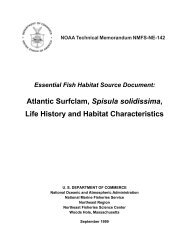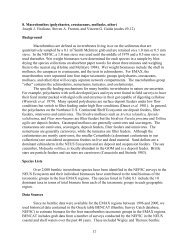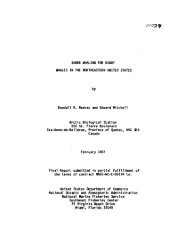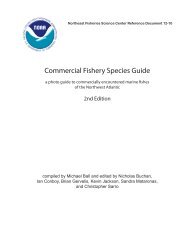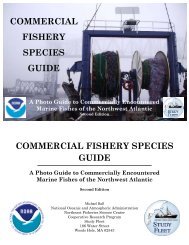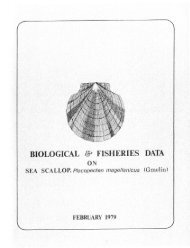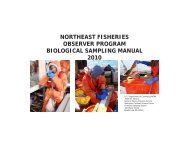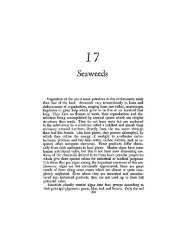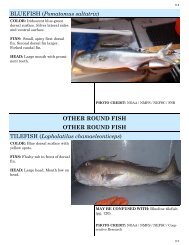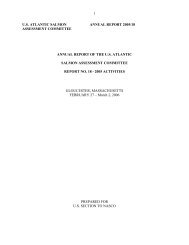Scup, Stenotomus chrysops, Life History and Habitat Characteristics
Scup, Stenotomus chrysops, Life History and Habitat Characteristics
Scup, Stenotomus chrysops, Life History and Habitat Characteristics
You also want an ePaper? Increase the reach of your titles
YUMPU automatically turns print PDFs into web optimized ePapers that Google loves.
INTRODUCTION<br />
<strong>Scup</strong> (<strong>Stenotomus</strong> <strong>chrysops</strong> Linnaeus 1766) (Figure<br />
1), is a temperate species that occurs primarily from<br />
Massachusetts to South Carolina, although it has been<br />
reported as far north as the Bay of Fundy <strong>and</strong> Sable Isl<strong>and</strong><br />
Bank, Canada (Bigelow <strong>and</strong> Schroeder 1953; Fritz 1965;<br />
Scott <strong>and</strong> Scott 1988) <strong>and</strong> as far south as Florida (Morse<br />
1978; Manooch 1984).<br />
The ‘southern porgy’ (S. aculeatus) is referred to in a<br />
number of South Atlantic Bight studies <strong>and</strong> reviews (e.g.,<br />
Morse 1978; Powles <strong>and</strong> Barans 1980; Sedberry <strong>and</strong> Van<br />
Dolah 1984), but is not considered a separate species by<br />
the American Fisheries Society (Robins et al. 1991)<br />
leading to some taxonomic confusion (T. Munroe,<br />
National Systematics Laboratory, Smithsonian Institution,<br />
Washington, DC, personal communication). For<br />
example, Miller <strong>and</strong> Richards (1980) list S. <strong>chrysops</strong> <strong>and</strong><br />
S. aculeatus as reef dwellers in the South Atlantic Bight.<br />
Although there can be some mixing of the Middle<br />
<strong>and</strong> South Atlantic Bight scup populations off North<br />
Carolina, the Middle Atlantic Bight population is treated<br />
separately here, because only this population appears to<br />
make extensive seasonal migrations <strong>and</strong> few fish tagged<br />
off New Engl<strong>and</strong> or New York have been caught south of<br />
Cape Hatteras (Nesbit <strong>and</strong> Neville 1935; Finkelstein<br />
1971). <strong>Scup</strong> in the Middle Atlantic Bight population are<br />
commonly found during the summer in larger estuaries<br />
<strong>and</strong> in coastal waters; during the winter, they occur along<br />
the outer continental shelf to about 200 m (656 ft) <strong>and</strong><br />
occasionally deeper. Beebe <strong>and</strong> Tee-Van (1933) reported<br />
that scup were introduced to Bermuda, but the status of<br />
that introduction is unknown <strong>and</strong> probably unsuccessful<br />
(B. Collette, National Systematics Laboratory,<br />
Smithsonian Institution, Washington, DC, personal<br />
communication). Archeological evidence suggests scup<br />
have been common in southern New Engl<strong>and</strong> waters for<br />
several thous<strong>and</strong> years <strong>and</strong> were used as food by native<br />
Americans (Waters 1967).<br />
The scup population in the Middle Atlantic Bight<br />
spawns along the inner continental shelf off southern New<br />
Engl<strong>and</strong> from May through August with a peak in June to<br />
July. Larvae occur in coastal waters during the warmer<br />
seasons, feed upon small zooplankton, <strong>and</strong> are prey to a<br />
variety of planktivores, including medusae, crustaceans<br />
<strong>and</strong> fish. Larvae settle to the seafloor in coastal <strong>and</strong><br />
estuarine waters when they are about 25 mm total length<br />
(TL), but this event is poorly documented. During the<br />
summer <strong>and</strong> early fall, juveniles <strong>and</strong> adults are common<br />
in most larger estuaries <strong>and</strong> coastal areas in open <strong>and</strong><br />
structured habitats where they feed on a variety of small<br />
benthic invertebrates. <strong>Scup</strong> begin to mature at 2 years of<br />
age (Finkelstein 1969b) at about 15.5 cm fork length (FL)<br />
(O'Brien et al. 1993). Most fish are mature at 3 years <strong>and</strong><br />
at 21 cm FL (Gabriel 1998). In the last century, scup ≥ 45<br />
cm FL were reported (Baird 1873) living to about 20<br />
years <strong>and</strong> weighing about 2 kg (Bigelow <strong>and</strong> Schroeder<br />
Page 1<br />
1953). Currently, the population in the Middle Atlantic<br />
Bight is composed primarily of fish ≤ 7 years <strong>and</strong> ≤ 33 cm<br />
FL (Northeast Fisheries Science Center 1997). Since the<br />
1930s, there has been a significant decline in the average<br />
size of scup; small scup have slightly different habitat <strong>and</strong><br />
prey requirements than larger scup (Smith <strong>and</strong> Norcross<br />
1968).<br />
LIFE HISTORY<br />
The life history of scup is typical of most demersal<br />
fishes, with pelagic eggs <strong>and</strong> larvae, <strong>and</strong> a gradual<br />
transition to the demersal adult stage. As a temperate<br />
species, scup is at the northern limits of its range in the<br />
northeastern United States <strong>and</strong> migrates south in the<br />
winter to warmer waters south of New Jersey.<br />
EGGS<br />
<strong>Scup</strong> eggs are small, 0.8-1.0 mm in diameter, <strong>and</strong><br />
buoyant (Kuntz <strong>and</strong> Radcliffe 1918; Wheatl<strong>and</strong> 1956).<br />
They require two to three days (40-75 hrs) to hatch<br />
depending on temperature (Griswold <strong>and</strong> McKenney<br />
1984). Little else is known of this ephemeral stage.<br />
LARVAE<br />
The newly hatched larvae are about 2.0 mm TL,<br />
pelagic, <strong>and</strong> depend on their yolk for about three days<br />
until they are about 2.8 mm TL (Bigelow <strong>and</strong> Schroeder<br />
1953) when active feeding begins. After reaching 15-30<br />
mm TL in early July, the larvae become demersal in shoal<br />
waters (Lux <strong>and</strong> Nichy 1971; Johnson 1978; MAFMC<br />
1996; Able <strong>and</strong> Fahay 1998). Griswold <strong>and</strong> McKenney<br />
(1984) considered the larvae as juveniles when they grow<br />
to about 18-19 mm TL. There is no information available<br />
on habitat use or requirements during this transition<br />
period.<br />
JUVENILES<br />
Able <strong>and</strong> Fahay (1998) noted that the smallest,<br />
young-of-the-year (YOY) individuals appeared in<br />
estuaries in June. In southern New Engl<strong>and</strong>, juvenile<br />
scup grew to 5 to 10 cm FL by November (Bigelow <strong>and</strong><br />
Schroeder 1953; Gottschall et al., in review). Returning<br />
juveniles in the spring were about 10-13 cm FL<br />
(Michelman 1988; Able <strong>and</strong> Fahay 1998). Growth of<br />
YOY scup is considered relatively slow (Able <strong>and</strong> Fahay<br />
1998). Michelman (1988) estimated daily growth of<br />
juveniles to be 0.84% of its dry wt/day using a length<br />
frequency method <strong>and</strong> 0.93% of its dry wt/day using a<br />
bioenergetics method. The growth production rates were




